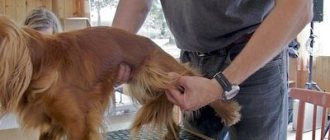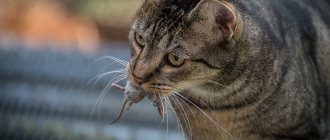Causes of the disease
A fracture is a violation of the anatomical integrity of the bone and adjacent tissues. It can be acquired or congenital and occur under the influence of external force or pathology, respectively.
If we talk about congenital pathologies of the bone structure, they are diagnosed in only 1-2% of the total number of visits to veterinary clinics with fractures. The reasons for the birth of kittens with limb fractures are intense labor, osteoporosis, rickets, osteomalacia in the expectant mother.
Veterinarians distinguish two types of acquired bone injuries based on the cause of their occurrence: pathological and traumatic. The first group includes fractures that occurred as a result of osteosarcoma, osteomalacia, etc.
Traumatic fractures occur not only due to various injuries received as a result of falling from a height, being run over by a car, or fighting with an opponent, but also due to unprofessional obstetric care.
Unlike a fracture, a dislocation is a violation of the anatomical location and a change in the physiological functions of the joint. The bone remains intact. Dislocations are also divided into two categories: acquired and congenital. The causes of dislocations are similar to those of fractures.
Not a single animal is insured against acquired dislocations and fractures. Breeds such as Persians, Maine Coons, and Himalayan cats are predisposed to congenital joint pathologies.
Why do dislocations occur?
In order for a healthy joint to dislocate, significant effort must be applied, and most often in dogs and cats dislocations occur as a result of various injuries.
- auto injury;
- playing injury;
- getting limbs into holes;
- getting a limb stuck while moving;
- falling from a great height;
- collision with an obstacle at high speed.
What does a dislocation look like?
With a congenital dislocation, the main symptom is lameness; with a traumatic dislocation in cats, the animal cannot lean on the paw, which is unnaturally deployed and swollen. After an injury, the cat jumps on three legs.
X-ray of a dislocation in a cat Diagnosing a dislocation
Congenital dislocations and subluxations develop due to a genetic marriage of abnormal joint structure. Often these pathologies are recognized already in adulthood (6–8 months and older), sometimes as an accidental finding. From the practice of a veterinarian: The most common traumatic dislocations are the hip, elbow, and in cats, the jaw and wrist joints.
Externally, upon careful examination, you can see: swelling, asymmetry and deformation of the contours of the damaged joint (compared to the limb on the opposite side). in case of dislocation of the lower jaw - misalignment of teeth. Palpation during traumatic dislocations is difficult - when palpated, the animal experiences sharp pain.
We suggest you read: First aid for sprains, dislocations and bruises of joints
A characteristic symptom is elastic (“rubber”) fixation of the joint, which normally works like a lubricated hinge. You can also feel bone-on-bone friction, grinding, clicking, and displacement of anatomical landmarks (for specialists).
What does a dislocation look like?
With a congenital dislocation, the main symptom is lameness; with a traumatic dislocation in cats, the animal cannot lean on the paw, which is unnaturally deployed and swollen. After an injury, the cat jumps on three legs.
Congenital dislocations and subluxations develop due to a genetic marriage of abnormal joint structure. Often these pathologies are recognized already in adulthood (6–8 months and older), sometimes as an accidental finding. From the practice of a veterinarian: The most common traumatic dislocations are the hip, elbow, and in cats, the jaw and wrist joints.
Externally, upon careful examination, you can see: swelling, asymmetry and deformation of the contours of the damaged joint (compared to the limb on the opposite side). with dislocation of the lower jaw - misalignment of teeth. Palpation during traumatic dislocations is difficult - when palpated, the animal experiences sharp pain.
A characteristic symptom is elastic (“rubber”) fixation of the joint, which normally works like a lubricated hinge. You can also feel bone-on-bone friction, grinding, clicking, and displacement of anatomical landmarks (for specialists).
Main symptoms
In case of fractures and dislocations, the animal exhibits general clinical signs: pain, impaired motor function (lameness), swelling of the damaged area.
There are three types of fractures: closed, open, and displaced. Serious damage also includes cracks.
Signs of an open fracture in a cat:
- violation of the integrity of the skin;
- the bone is broken, its ends are displaced and protrude;
- tissue rupture in the fracture area;
- bleeding;
- strong pain.
With open wounds, the risks of tissue necrosis and infection are very high.
A closed fracture without displacement is characterized by the following symptoms: the broken bone is in its usual position, the skin and tissues swell, turn blue, and turn red. In a displaced fracture, the bone diverges in different directions, and the soft tissue is partially damaged. There is a danger of internal bleeding.
A crack can easily be confused with a bruise. The bone remains intact, its edges do not diverge and are held in place by the intact area. The cat may move carefully, but it may be in pain.
A simple dislocation is recognized by the following signs:
- skin and tissue remain intact;
- lameness;
- inability to lean on the surface;
- pain when touching the injured limb;
- The dislocated part of the body is asymmetrical.
A complex dislocation, accompanied by rupture of ligaments and tendons, is characterized by the appearance of hematomas in the injured area.
Bruise in a cat - how to identify and how to treat
A type of mechanical injury in domestic cats and dogs is a bruise. The damage is characterized by a violation of the integrity of blood and lymph vessels, as a result of which subcutaneous hemorrhage develops, but the skin remains, in the vast majority of cases, completely untouched.
The location of the bruise swells, the animal clearly shows anxiety, feeling discomfort and pain. The bruised limb is not used by the animal; the cat avoids stepping on the paw, heals and licks it.
A feature of domestic cats is increased mobility and curiosity, especially in small kittens. Kids always play actively, performing mind-blowing stunts that often end in mild to moderate injuries. In some cases, the injury can be caused by another cat or cat, as well as a dog.
The situation is much more serious if the pet has free access to the street. In this case, the risk of serious injury to the cat increases.
A caring cat owner should know how to distinguish a normal bruise of a pet's body part from more serious injuries.
What symptoms are typical for bruises of the limbs and body, and also in what cases it is necessary to contact a veterinary clinic for help as soon as possible.
Various fractures and serious dislocations are dangerous for the animal and cannot be avoided without the intervention of a specialist.
Bruises in cats, cats and kittens, degrees and prognosis for recovery
Depending on the severity of the injury, the symptoms and condition of the animal will vary. In veterinary medicine there is a certain classification of bruises by degree. There are 4 degrees of bruises in cats.
The first includes injuries that are characterized by trauma to the inner part of the skin and subcutaneous fat. Wound surfaces in the form of a scratch or abrasion may appear on the surface at the location of the bruise.
The site of injury may cause discomfort to the animal, swelling and bruising may occur.
The duration of tissue regeneration in case of a first-degree injury is unusually fast and does not require the intervention of the owner or specialist.
Second-degree bruises are more often diagnosed in cats on the hind legs and are caused by falls from great heights.
Such bruises are characterized by pronounced delamination and rupture of muscle fibers at the site of injury, swelling and inflammation. Such a bruise is accompanied by the development of an extensive hematoma.
This type of damage sometimes provokes an increase in body temperature, a change in the rhythm of breathing and pulsation of the arteries.
A dangerous third degree injury is diagnosed quite often and poses a serious danger to the cat’s normal life, depending on the location of the injury. Third-degree bruises are most often diagnosed in the cat’s spine, accompanied by fractures and cracks of bone structures, rupture of tendon ligaments and muscle fibers.
Often, when falling from a great height, not only bones, but also joints are injured. After suffering a blow and subsequent bruise, the animal is in a state of shock. In the absence of timely assistance, death of tissue structures at the site of damage is observed. Disorders of the central nervous system are often diagnosed, especially in cases of damage to the spine and skull.
The last degree of gradation of bruises is the fourth, the most dangerous, threatening the life of the animal. With fourth-degree bruises, serious crushing of tissue structures and crushing of bones occurs. The surface layers of the skin at the site of injury are open to various pathogenic microflora.
The penetration of bacteria and fungi into the affected area leads to the development of purulent-necrotic processes, up to abscesses or sepsis. Fourth degree bruises, as a rule, occur on the animal’s limbs and it is very rare to save them. Amputation of the damaged limb and further long-term rehabilitation of the pet are carried out.
Bruises of the first and second degrees are mild, do not require special treatment, and go away quickly and independently in a few weeks. The prognosis is favorable.
A diagnosed third-degree bruise implies a cautious prognosis, and in the case of a fourth-degree bruise, the prognosis is unfavorable.
How to identify a bruise
If a cat is bruised, the owner is unlikely to remain unaware. The resulting injury in the area of the hind or forelimbs leads to the fact that the cat has a pronounced limp, holds the affected paw in a taut state, trying as much as possible not to let the paw come into contact with a hard surface.
The cat stops stepping on the limb, and if it does, with mild degrees of damage, it becomes noticeably lame, automatically transferring the weight of its body to other supports.
There are several main signs of a bruise in a cat that will help the owner suspect a pathological condition and take the animal to a veterinary clinic.
The main symptoms of bruises are:
- swelling when a paw is bruised in the area of the affected limb (swelling develops against the background of accumulation of lymphatic fluid and blood from ruptured vessels into the subcutaneous fatty tissue);
- hematoma (bruise) at the site of the lesion;
- disturbance of the cat’s normal gait and severe lameness;
- the animal anxiously tries to lick the sore spot, stimulating microcirculation for speedy resorption of the bruise;
- an increase in temperature at the site of damage, but not locally;
- aggression of the pet when the owner tries to touch the damaged area.
At the same time, against the background of a bruise, the cat should not have any significant damage to the integrity of the skin, as well as violations of the joint and bones on the paw.
Severe or minor bruises of the first and second degree under normal conditions disappear within a week.
Swelling gradually decreases, gait normalizes, and the animal becomes normal. If the bruise is associated with damage to ligaments or muscle fibers, consultation and treatment cannot be avoided.
It is important to know how to correctly distinguish a true bruise from a possible fracture or dislocation. So, with fractures in a cat, a visual change in the structure of the limb or other damaged part of the body is observed. The pet experiences severe pain at the site of injury, plaintively asking for help.
By gently palpating the affected limb, the owner will be able to feel for instability of the bone. In addition, with fractures, edema develops not only in a certain place, but is distributed over large areas.
With dislocations, the clinical picture has the following characteristic feature. At the site of dislocation, the boundaries of the exit of the head of the bone from the articular capsule are clearly defined. The limb weighs like a whip, and the cat cannot use it. In such cases, you cannot set the bone yourself; you must contact a specialist.
Diagnostics in a veterinary clinic
The fact that the pet has been injured is immediately obvious, but a visit to the veterinary clinic is necessary. After examining your pet and conducting a series of diagnostic tests, the veterinarian will determine the extent of the damage and prescribe appropriate treatment.
Necessary diagnostic methods include general and biochemical blood tests, x-rays in two projections, and cardiac echocardiography. In some cases, an abdominal ultrasound is required.
Home care
If you have witnessed your cat being hit by a car or falling from a great height and you suspect a fracture, you should put a splint on the injured paw. This procedure will immobilize the broken limb. A flat board can be used as a tire, or, in the absence of one, thick cardboard folded several times.
The splint must be applied in such a way as to be able to fix two joints close to the fracture, below and above. The structure should be wrapped with a bandage in several layers. After this, you need to take the victim to a veterinary clinic.
For open fractures, the wound is closed with sterile gauze, and a splint is applied on top.
If you are sure that your cat has a dislocation, then under no circumstances try to straighten the injured limb yourself! With your inexperienced actions and ignorance of cat anatomy, you can cause irreparable harm to your pet. Apply an ice pack to the affected limb, apply a tight bandage, and take your pet to a veterinarian.
To alleviate the cat’s condition and relieve it from traumatic shock, many owners inject the animal with an anesthetic. However, veterinarians do not recommend doing this at home. Without feeling pain, a cat can cause even more harm to itself.
In addition, analgesics distort the symptoms of injury. Finally, sedation will be required during the X-ray examination, and pre-administration of pain medication will negatively affect the health of the pet.
The animal should be transported to the veterinary clinic lying down in the back seat of the car. The pet should be placed on a horizontal surface - plywood, board, car panel - and secured in the area of the shoulder blades and pelvis with a rope or belt.
The owner’s task is to provide the pet with the most comfortable living conditions during treatment of fractures. A cat's mobility can have a negative impact on its well-being, so freedom of movement should be limited. The ideal option would be to place the animal in a cage for 2-3 weeks.
This design should be quite free, but at the same time not allowing the pet to move a lot. You need to put a tray and bowls of food and water in the cage.
Dislocated paws in cats: how to recognize the injury and help your pet
Active and playful furry pets often become hostages of their own restlessness. Poor maneuvers, jumping from heights and sometimes abuse lead to various injuries. Veterinarians call various dislocations in cats one of the most common reasons for visiting the clinic.
Causes of dislocation
The reasons why a cat can get dislocated are divided:
- For traumatic or acquired
- To congenital.
Congenital dislocations in cats occur due to abnormal joint structure or impaired mobility, which is called dysplasia. Such pathologies make themselves felt at the age of 6 months and older.
Reference! Persian, Himalayan and Maine Coon breeds are genetically predisposed to congenital joint pathologies.
Sometimes the cause of a dislocation lies in a chronic disease that the cat has, during which joint and bone tissue is destroyed. These diseases include rickets, osteoporosis and osteomalacia.
A cat may twist its paw or dislocate its tail if it makes an unsuccessful jump or falls from a height. Colliding with an obstacle at high speed, car injuries, or cruel treatment of a cat often leads to dislocation of a healthy joint.
An animal can get injured in its front and hind legs while playing with a small child. Such dislocations are most often diagnosed in small kittens whose legs are roughly pulled. Fights with relatives or other animals can also cause a traumatic dislocation.
What types of dislocations exist in cats?
With any type of dislocation, the cat experiences severe pain.
Depending on the time when the cat received the dislocation, injuries vary:
- fresh or recent, which were received less than 3 days ago;
- not fresh – the dislocation occurred about 2 weeks ago;
- neglected - the animal was injured more than 3 weeks ago.
Dislocation in a cat can be complete or incomplete:
- In case of complete dislocation, the ends of the bones forming the joint do not touch each other; in case of incomplete dislocation, they do.
- Incomplete dislocation is also called subluxation.
Dislocation can be simple, when the soft tissues and skin remain intact, or complex. A complex dislocation is accompanied by rupture of ligaments and tendons, and fractures inside the joints.
Symptoms of a dislocation in a cat - how to recognize
A dislocation is the displacement of bones relative to each other without damaging them. By shifting from their anatomical position, bones can damage soft tissue, adjacent tendons, blood vessels and ligaments.
A dislocated limb looks unnatural.
You can recognize a dislocation in a pet by the following symptoms:
- with a congenital dislocation, the animal is lame on one leg;
- with a traumatic dislocation, the cat cannot fully lean on the surface;
- The pet experiences pain from touching the damaged area;
- Not only the gait changes, but also the behavior of the animal: sleep becomes restless, the cat tries to lick the site of the dislocation;
- The dislocated part of the body is usually asymmetrical. A dislocation may be indicated by its unnatural position, the protruding part of the displaced bone;
- With a complex dislocation, ruptures and hematomas are observed in the damaged area.
How to identify a hip dislocation
The hip joint in a cat is quite simple, but despite this, it is the strongest and most mobile. Dislocation of the hip joint (dislocation of the femoral head) is a relative displacement of the femur relative to the pelvis, accompanied by rupture of the round ligament and overstretching of the joint capsule.
An animal that has damaged the hip joint cannot step on the affected limb, which, as a rule, becomes shortened.
Attention! Dislocation of the femoral head is one of the most severe.
Dislocation of the front or back paw
Habitual dislocation causes a lot of inconvenience to the animal.
A dislocation of the front paw in an animal has a similar clinical picture to a dislocation of the hip joint. The cat cannot lean on the affected limb. A dislocated hind or front paw looks asymmetrical, and there is swelling at the site of the dislocation.
Tail dislocation
The tail gives the cat grace, serves as a kind of balancing device and is an extension of the spine. A cat can dislocate its tail in a fight or when hit by a car.
Even the most caring owner can accidentally injure a cat by stepping on its tail or pinching it in a door. Externally, a dislocated tail appears crooked.
His mobility decreases, the cat experiences pain.
How to give first aid to a cat
Owners of furry pets, having discovered signs of dislocation in their animal, often feel confused and do not know what to do. Only a veterinarian can provide proper first aid to a cat.
Attention! Do not try to correct the dislocation yourself, you will cause pain to the animal and aggravate the situation.
The actions of the cat owner in case of dislocation should be as follows:
- If possible, immobilize the injured limb: apply a splint, fix the paw with a ruler or a small board.
- Limit the animal's space by placing it in a cage, carrier or box.
- Do not touch or knead the damaged area.
- If you find a fresh sprain, apply ice to it for half an hour.
- Severe pain can be relieved with an anesthetic injection.
- Before visiting the veterinarian, do not try to feed or drink your cat. The animal may need anesthesia.
Pain from a sprain can be controlled with medications.
Almost all injuries are accompanied by severe pain. The owner can independently reduce it by anesthetizing the animal. Special veterinary drugs are well suited for this purpose:
- ketofen,
- nalbuphine,
- butomidor.
If you don’t have them at hand, you can inject analgin by injecting 0.4 ml intramuscularly (dose for an average cat). It is better not to give popular tablet painkillers: baralagin and analgin to your cat. They cause the animal to salivate heavily.
The danger for the animal is traumatic shock, which can lead to vasospasm. This phenomenon negatively affects the functioning of the liver and kidneys.
Antishock therapy helps eliminate it. An injured cat should be given corticosteroid drugs, for example, prednisolone (0.3-0.5 ml intramuscularly).
At the veterinary hospital, anti-shock therapy will be continued using drip infusion.
A cat that has dislocated a limb needs urgent transportation to a veterinary clinic. There she will receive professional help: an x-ray and, if necessary, surgery. The older the dislocation, the less chance there is of non-surgical reduction.
Diagnostics in the clinic
An X-ray is the most informative type of research for a dislocation.
Before diagnosing a dislocation in a cat, the veterinarian conducts a series of studies, which include:
- collecting anamnesis to identify the nature and cause of the injury;
- visual inspection and palpation;
- X-ray examination, which is the most effective and reliable method.
Reduction of dislocation in hospital
A caring owner, when his pet is injured, is first puzzled by the question of how to treat the dislocation. Treatment of dislocations in cats can be conservative (closed) or surgical (open).
Conservative reduction of a dislocation is performed under general anesthesia, as this procedure is very painful. In addition to sleeping pills, the animal is given medications that relax the muscles.
After the joint is returned to its original position, the limb is fixed with a splint or bandage. The animal must wear it for 10 days. After the dislocation has been reduced, the cat must undergo a rehabilitation period, during which the owner will follow the doctor’s instructions and recommendations.
The animal's physical activity during the recovery period should be moderate. The duration of rehabilitation depends on the severity of the injury.
For reference! To check the success of the procedure, the reduced limb is flexed and extended, moved to the side and a control x-ray is taken.
Operation for advanced cases
Surgery is necessary for advanced or complex dislocations.
After receiving an injury, the dislocation must be corrected as soon as possible. Delay in receiving medical help leads to muscle contraction, the formation of a dense blood clot and scar tissue. These changes make it difficult to reduce the dislocation using a closed method. In such cases, the question arises about surgical treatment of advanced dislocations.
During the operation, during which the animal is asleep, an incision is made in the joint area, through which fibrin clots and destroyed parts of the joint are removed. The joint returns to its original position; this will require force or special levers. A joint reduced openly also requires fixation and temporary immobilization.
Sometimes a cat requires surgical fixation of a joint:
- for dislocations of the hip or wrist joints, it is carried out using special pins;
- for elbow and ankle - screws and wires.
Congenital dislocations in furry pets are usually eliminated using the open method. After a minor dislocation, the animal recovers within 3-4 days. The cat can use its paw, but has a slight limp. Full recovery from severe dislocations takes about 3-4 weeks.
Why is an advanced dislocation dangerous?
An advanced dislocation is dangerous due to suppuration, amputation and sepsis.
Timely seeking help from a veterinarian helps to avoid possible complications:
- Neglected dislocations can lead to serious consequences.
- An animal that is in constant pain will become aggressive and disobedient.
- The paw will not heal properly, leaving the cat lame.
- A severe dislocation can lead to muscle atrophy and paralysis of the limb.
- The resulting swelling and inflammation can cause blood poisoning, which can lead to amputation of a limb at best, or the death of the animal at worst.
It is practically impossible to avoid acquired dislocations. No owner will be able to follow on the heels of a restless pet, who strives to climb higher or make a bold leap.
Veterinarians advise pet owners who live in apartments to close windows and not let cats out onto the balcony. The games of a cat and a small child need to be supervised, because the baby can unknowingly cause harm to the animal. Take care of the health of your purring pet, and he will respond with affection and affection.
In the video, a veterinarian talks about injuries in cats:
Source: https://koti-koshki.ru/vyvih-u-koshki.html
Rehabilitation period
How long the recovery phase will last depends on the severity of the fracture, the general condition and age of the cat. In young individuals, it usually lasts three weeks, with a maximum of 30 days. In an old cat, the healing process is longer - 35-40 days.
To monitor proper fusion of the bone structure, your pet should be taken to a veterinary surgeon for a monthly check-up.
In order to restore the motor function of the damaged limb, elasticity and muscle tone, manual massage should be performed, the technique of which will be introduced by the veterinarian. Daily massage procedures stimulate blood circulation, healing of periosseous tissues, and accelerate the process of bone fusion.
A cat's diet should be balanced, nutritious and easily digestible. The animal needs foods enriched with phosphorus and calcium. However, we must remember that an excess of these components often leads to the formation of stones in the gall bladder and kidneys.
Vitamin and mineral supplements will also help speed up your pet's recovery, but they can only be given after consultation with a specialist. The veterinarian prescribes vitamins based on the animal’s needs.
Operation for advanced cases
Surgery is necessary for advanced or complex dislocations.
After receiving an injury, the dislocation must be corrected as soon as possible. Delay in receiving medical help leads to muscle contraction, the formation of a dense blood clot and scar tissue. These changes make it difficult to reduce the dislocation using a closed method. In such cases, the question arises about surgical treatment of advanced dislocations.
During the operation, during which the animal is asleep, an incision is made in the joint area, through which fibrin clots and destroyed parts of the joint are removed. The joint returns to its original position; this will require force or special levers. A joint reduced openly also requires fixation and temporary immobilization.
Sometimes a cat requires surgical fixation of a joint:
- for dislocations of the hip or wrist joints, it is carried out using special pins;
- for elbow and ankle - screws and wires.
Congenital dislocations in furry pets are usually eliminated using the open method. After a minor dislocation, the animal recovers within 3-4 days. The cat can use its paw, but has a slight limp. Full recovery from severe dislocations takes about 3-4 weeks.











